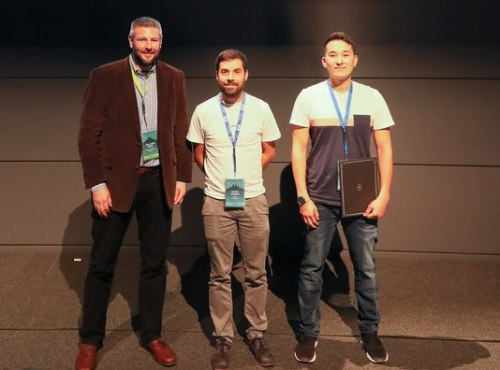Poster award for HZB PhD student

John Uhlrich, Editor-in-Chief at Wiley VCH presented an award to Quentin Jeangros, EPFL, and Eike Köhnen, HZB, for their outstanding posters (from left to right). © Gruppe Steve Albrecht/HZB
Eike Köhnen received an award for his poster on perovskite silicon tandem cells at the 4th International Conference on Perovskite Solar Cells and Optoelectronics (PSCO) in Lausanne, Switzerland. He is a PhD student in the Junior Research Group on Perovskite Tandem Cells led by Dr. Steve Albrecht.
Tandem cells made of organometallic perovskite layers and silicon have the potential for very high efficiencies. While perovskites in particular convert blue parts of the light spectrum into electrical energy, silicon uses the red parts of the light. Eike Köhnen is working on the design of a so-called monolithic tandem cell.
For his poster, which he presented at the 4th International Conference on Perovskite Solar Cells and Optoelectronics (PSCO) in Lausanne, Switzerland, he received an award sponsored by Wiley Science Publishers.
Köhnen has realized a highly efficient monolithic tandem solar cell with an efficiency of 25 percent, which has also been certified by independent bodies. The tandem cell was manufactured at HZB, the silicon cell being produced at HZB-Institute PVcomB and the perovskite cell at HySPRINT. By optimizing the optical and electrical properties of the tandem-top contact, it was even possible to achieve an efficiency of 26 percent, which is the highest efficiency currently published in the literature for this tandem architecture. Since the spectrum arriving on Earth changes over the course of the day, Köhnen also investigated the influence of the spectrum on the behavior of the tandem solar cell.
arö
https://www.helmholtz-berlin.de/pubbin/news_seite?nid=14951;sprache=en
- Copy link
-
New Helmholtz Young Investigator Group at HZB on perovskite solar cells
Silvia Mariotti is returning to HZB as head of the new Helmholtz Young Investigator Group ‘Perovskite-based multi-junction solar cells’. The perovskite expert, who was previously based at Okinawa University in Japan, aims to advance the development of multi-junction solar cells made from different perovskite layers.
-
Hydrogen storage in MXene: It all depends on diffusion processes
Two-dimensional (2D) materials such as MXene are of great interest for hydrogen storage. An expert from HZB has investigated the diffusion of hydrogen in MXene using density functional theory. This modelling provides valuable insights into the key diffusion mechanisms and hydrogen's interaction with Ti₃C₂ MXene, offering a solid foundation for further experimental research.
-
HZB and National University Kyiv-Mohyla Academy start cooperation in Energy and Climate
Helmholtz-Zentrum Berlin für Materialien und Energie GmbH (HZB) and the National University of "Kyiv-Mohyla Academy" (NaUKMA) have signed a Memorandum of Understanding (MoU). The MoU serves as the starting point for collaborative research, academic exchange, and capacity-building between the two institutions. Actions will be taken to establish the Joint Research and Policy Laboratory at NaUKMA in Kyiv. The aim of the future laboratory is to jointly develop research and policy analysis, focusing on the energy and climate dimensions of Ukraine’s EU integration.
